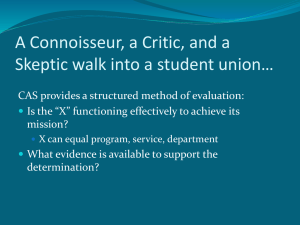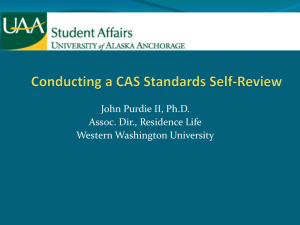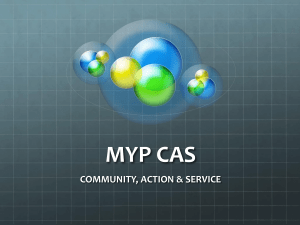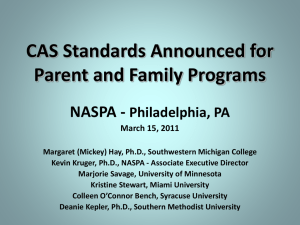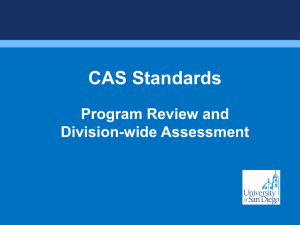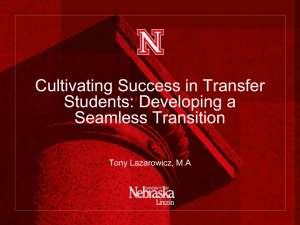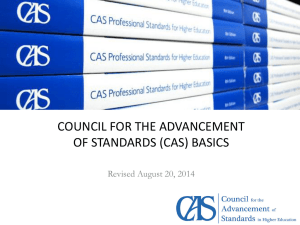SAGS - Southern Association for College Student Affairs
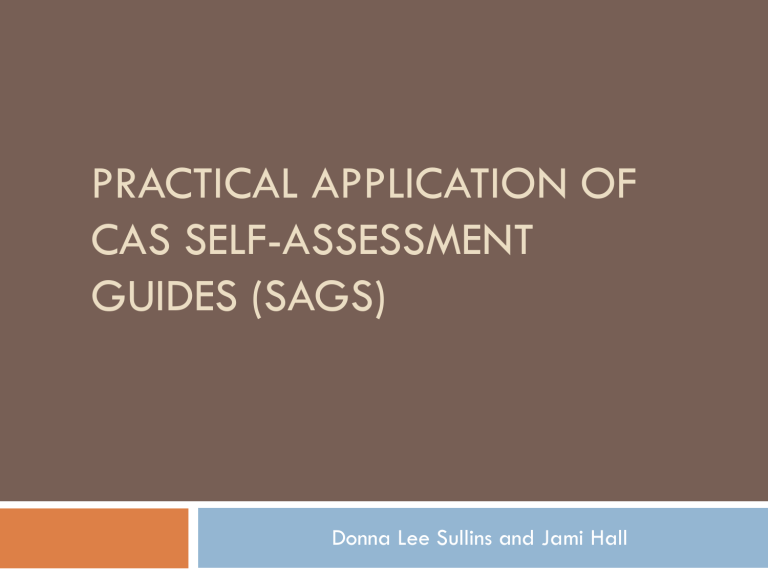
PRACTICAL APPLICATION OF
CAS SELF-ASSESSMENT
GUIDES (SAGS)
Donna Lee Sullins and Jami Hall
Who are we?
Not experts…just practitioners
Donna Lee Sullins
Associate Director of Student Life
Student Conduct
Jami Hall
Director of Student Life
Student Programming
Learning Outcomes
Participants will understand the purpose of voluntary self evaluation.
Participants will be aware of multiple approaches to using CAS Self-Assessment Guides on their campuses.
Participants will be able to outline the steps to use a
CAS Self-Assessment Guide on their campuses.
Pre-test time!
What is CAS?
What is a SAG?
Has anyone done a SAG?
How comfortable do you feel leading a SAG review in your office?
Assessment you are currently doing
What is your office doing?
Why? What goals are to be accomplished in so doing?
What are your hopes for collaboration?
What is ?
“Founded in 1979, The Council for the Advancement of
Standards in Higher Education (CAS) is the pre-eminent force for promoting standards in student affairs, student services, and student development programs.”- CAS
CAS has eight guiding principles that are concerned with student learning and the environmental conditions at institutions needed to in order to promote leaning and development.
Member groups: ACPA, ACUHO-I, ACUI, ASCA,
NACA,NASPA, NIRSA, NODA…just to name a few
What is a SAG?
“An operational version of the CAS Standards and
Guidelines designed to provide users with an assessment tool that can be used for self-study or self-assessment purposes. A SAG is available for each functional area for which a CAS standard exists.” – CAS
CAS standards use of auxiliary verbs “must” and
“shall” that appear in bold print.
Guidelines use “may” and “should” appear in regular text.
SAG Review of Part 2. Program
SAG Review of Part 2. Program
8 th Edition
7 th Edition
How do you get a SAG?
www.cas.edu
CAS Professional Standards for Higher Education (8th edition) and the
Self-Assessment Guides - CD = $300
CAS Professional Standards for Higher Education (8th edition) = $85
Self-Assessment Guides - CD (all 43 functional areas) = $255
Individual Self Assessment Guide(s) = $35 each
A few ways of doing things
Timeline
Number of functional areas to evaluate
Who’s on your team
Implementation and review plan
Georgia Southern-
Center for Student Leadership 2005
One semester to complete
Group/Peer review
Outside/Inside perspective
Evidence collected as we went
Belmont University-
New Student Programs 2007
One month to complete
Individual review
Outside perspective
Hesitancy by office
Most evidence collected first
Dalton State College-
Office of Admission 2009
Lack of clear timeline when starting
Lack of diversity in team member selection
Lack of true desire to learn areas of needed improvement
Irregular meeting times
All this led to an incomplete review
Dalton State College-
Office of Student Activities/Life 2010-2012
One year original timeline
Cross Campus Team
Donna Lee Sullins, Student Life (2010-2012)
Jami Hall, Student Life (2010-2012)
Dr. Gina Kertulis-Tartar, Biology Faculty (2010-2012)
Dr. Kent Harrelson, English Faculty (2010-2011)
Dr. Christian Griggs, History Faculty (2011-2012)
Kim McCroskey, OCIS (2010-2011)
Kris Richardson, OCIS (2011)
Ashley Baugh, Business Services (2012)
Andrew Mailman, Student (2010)
Ashley Lindsey, Student (2010-2011)
Greg Ellis, Student (2012)
Review of 4 functional areas and the general SAG section by section
Collect evidence as we go
Once per month 3 hour meetings then later twice per month hour and a half meetings
Why can’t we be friends?
Typical organization scheme for higher education
Collaborations = Success
Student Life + Academic
Affairs = Perfect
Partners!
Often a (perceived?) disconnect
Share a common goal – student success
Perhaps a better organization plan is:
President
Fiscal
Affairs
Academic
Affairs
Questions to consider:
Who?
Personality!
Consider background & interests of individuals
What?
Establishing role(s) of each member is important
Do you really want “yes” men and women?
When?
Time commitment – frequency/duration
How?
Dissemination of information/materials
Amount covered in each meeting
Added validity and accountability
Self assessment – but what does “self” really mean?
Internally driven
Supports and encourages staff development
Develops a shared vision among various constituents
Post assessment follow through
Are recommendations considered?
What are the changes made?
Timeframe for changes?
Who benefits?
Students!
All interested parties
Creates
Open communication
Sustainability
Working relationships
Practice Time
Please get into groups of no larger than 10 by the following functional areas:
Assessment Services
Campus Activities Programs
Housing and Residential Life Programs
Multicultural Student Programs and Services
Orientation Programs
You will work on Part 1. Mission by accessing your office’s materials as best you can from the internet
Steps to get started tomorrow
1. Get your supervisor on board
2. Decide if done as a team or individually
a. Brainstorm area to be involved and key people to invite from those areas b. Invite Committee members
3. Set a time frame
4. Decide your approach as a team
5. Get other staff members on board to provide evidence and set deadline(s)
6. Create an action plan with timelines
7. Write a summary report (if you want to)
Worksheet B
Post test time!
What is CAS?
What is a SAG?
How comfortable do you feel leading a SAG review in your office?
References
Council for the Advancement of Standards in Higher Education.
(2012). CAS professional standards for higher education (8 th ed.). Washington, DC: Author.
Council for the Advancement of Standards in Higher Education.
(2012). Council for the advancement of standards in higher
education. Retrieved August 24, 2012. www.cas.edu.
Schuh, M. L., Upcraft, J. H., and Associates. (2001). Assessment
practice in student affairs: An applications manual. San
Francisco, CA: Jossey-Bass.
Upcraft, J. H. & Schuh, M. L. (1996). Assessment in student affairs: A
guide for practitioners. San Francisco, CA: Jossey-Bass.
Questions?
To Contact us:
Donna Lee Sullins
dlsullins@daltonstate.edu
Jami Hall
jhall@daltonstate.edu



